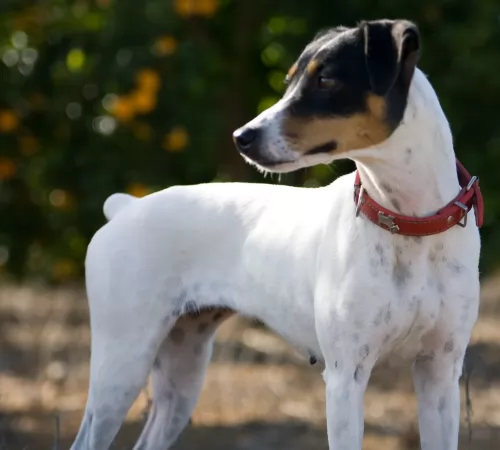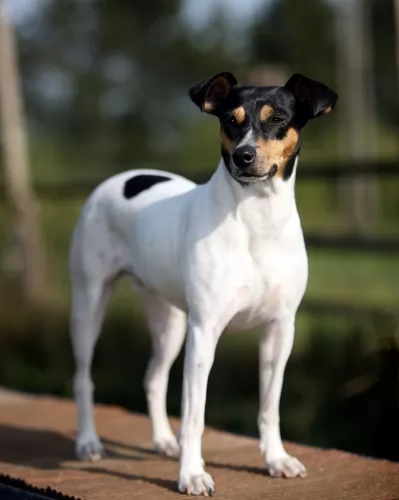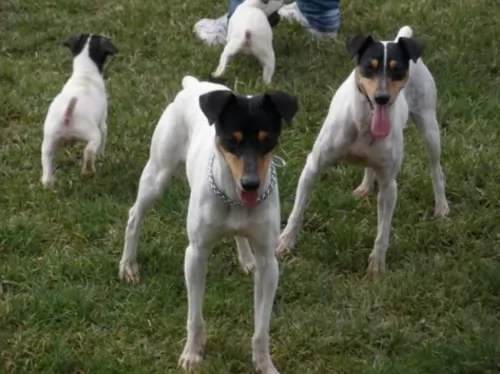 MyDogBreeds
MyDogBreedsRatonero Bodeguero Andaluz is originated from Spain but Guejae Gae is originated from South Korea. Ratonero Bodeguero Andaluz may grow 15 cm / 5 inches shorter than Guejae Gae. Ratonero Bodeguero Andaluz may weigh 18 kg / 39 pounds lesser than Guejae Gae. Ratonero Bodeguero Andaluz may live 4 years more than Guejae Gae. Both Ratonero Bodeguero Andaluz and Guejae Gae has almost same litter size. Ratonero Bodeguero Andaluz requires Low maintenance. But Guejae Gae requires Moderate maintenance
 Long ago the English visited Spain to sample their wines, bringing with them smooth coated English Fox Terriers which were later crossed with other dog breeds of the area.
Long ago the English visited Spain to sample their wines, bringing with them smooth coated English Fox Terriers which were later crossed with other dog breeds of the area.
It is believed that the Andalusia Ratter’s ancestors were smooth coated fox terriers. The Club Nacional del Perro Andaluz Ratonero Bodeguero was established and in 1993 a standard for the breed was set.
It is only fairly recently that the breed was recognized by the Royal Canine Society of Spain but it isn’t recognized by any of the major kennel clubs.
Known also as Gaulchae Gae, the Guejae Gae hails from Korea, and falls in the Spitz dog category. The dog is related to the Korean Jindo dog but is slightly larger.
With his sharp canine teeth, the Guejae has been used for hunting and herding, having enough stamina to not easily give up on its prey. The dog isn’t AKC recognized.
 Also known as the Spanish Jack Russell, the Ratonero Bodeguero Andaluz looks very similar to this popular Jack Russell Terrier.
Also known as the Spanish Jack Russell, the Ratonero Bodeguero Andaluz looks very similar to this popular Jack Russell Terrier.
He is a small to medium sized dog with a lean, muscular body. The Ratonero developed in the south of Spain and is thought to be a mix of local ratting dogs and Fox Terriers. This ensured a quick, agile hunter.
The dog stands at between 35 – 43cm in height and weighs 6 - 9kg. The dog’s head is fairly small with dark brown eyes and half erect-half floppy ears. The coat is mainly white with some freckling. It is short and smooth with shades of black and tan covering the facial area. Some of these dogs are born with a natural bob-tail.
These dogs are known to have robust, hearty, happy personalities, full of the joys of living. They get on well with children as well as other pets if they have grown up with them.
Introductions should be slow if one of these dogs are brought into a home where there are already other pets. He is a very active breed and will be requiring plenty of mental stimulation and physical exercise.
They can provide quite a bit of entertainment for their human families as they can become quite clownish. They’re the kind of dogs that can adapt to life in the countryside or the city.
This is a medium sized dog, standing at roughly 40cm to 58cm and weighing about 16 to 27kg, and because he falls into the Spitz dog category, you’ll find them with the characteristic pointed ears and thick fur.
He can be in a number of colors such as fawn, brown, white, grey or black. The tail curls up over the back too and the dog has a resemblance to the wolf. You can see he is intelligent as has he has bright, alert eyes.
These dogs aren't aggressive and they are known to be gentle dogs who are devoted and loyal to their owners.
He is an active, intelligent, social dog who wants ongoing interaction with his human family. He should never be left alone in the back yard day after day as he becomes lonely and bored. This is terrible to do for any dog breed, but the Guejae Gae won't thrive in a family who doesn't make him 100% part of the family.
He should be allowed indoors with his owner as he is a highly social dog who loves being around his human family, forming deep bonds with them.
His superb intelligence allows him to learn new commands and tricks easily, and this is why he responds well to training and socialization. He makes a great pet for active owners and gets on well with children in the home as well as pets. Because he is somewhat reserved around strangers, he makes a good watchdog too.
 Your Ratonero Bodeguero Andaluz to this day is a ratter, always alert and ready to spring on prey. He is always lively and friendly, and with his loving nature, makes a splendid companion for his human family.
Your Ratonero Bodeguero Andaluz to this day is a ratter, always alert and ready to spring on prey. He is always lively and friendly, and with his loving nature, makes a splendid companion for his human family.
He is also a stubborn dog, liking to go his own way, and therefore will require training and socialization. He is an adaptable little dog too and when you bring him into your home he is willing to adapt to your way of life and become a loyal and loving member of your family.
Intelligent, playful, faithful and loving, your Guejae Gae is going to make you a splendid pet – good with other pets in the home as well as with children.
They are good natured pets and easy to train too, so that when he has been trained and socialized, he becomes an even more amicable pet.
Just remember though that these dogs have been used as working dogs and to ensure your Guejae Gae makes you a splendid pet, you want to ensure he has enough exercise to keep him happy and healthy.
 With good care, your Andalusian Ratter isn’t likely to get sick, but still, you would be better off knowing about some of the common dog diseases your pet could get.
With good care, your Andalusian Ratter isn’t likely to get sick, but still, you would be better off knowing about some of the common dog diseases your pet could get.
This is usually seen in young dogs where there is lameness in the hind legs and hip pain. It is believed that Legge Perthe’s occurs because of a genetic predisposition, and when it develops, there is sadly no cure.
Skin infections may seem fairly mild but nothing can be further from the truth. They can be painful and frustrating. Skin redness, dryness, itchiness and pain can cause your pet to lick and bite and make the situation worse. If your pet is being driven crazy by a skin irritation, get him to the vet who will do a complete physical examination.
Other diseases to be aware of include hip dysplasia, obesity, epilepsy and bloat.
There are always common dog illnesses to watch out for however, and in this spitz-type dog, hypothyroidism is one.
Hypothyroidism in dogs is usually brought on by inflammation of the thyroid gland. Hypothyroidism occurs more often in medium to large dogs as opposed to smaller breeds. The most common signs of low thyroid function in your pet will be loss of fur and excess shedding, weight gain and an inability to tolerate the cold.
Hypothyroid dogs often battle with ear infections as well as skin infections. There are a number of blood tests to confirm a suspected diagnosis of hypothyroidism in your dog.
 This is a fairly low maintenance dog as the short smooth coat will be easy to brush twice a week.
This is a fairly low maintenance dog as the short smooth coat will be easy to brush twice a week.
Check him over for unusual lumps, trim his nails and check inside his ears, look into his eyes to ensure they are bright and alert and look inside his mouth to make sure he doesn’t have any rotten teeth.
Have your pet neutered or spayed if you want to avoid puppies. This can be beneficial for your pet’s health too.
Feed your Ratonero Bodeguero Andaluz only the best food there is. If you opt for commercially manufactured food, make sure its full of vitamins and minerals. Your little pet will want consistency and simplicity with his food to avoid digestive problems.
Try and provide him with some home-made food which can be added to the dry kibble twice a week as a treat. Boiled chicken, brown rice or pasta and spinach, sweet potatoes and carrots all chopped up ad mixed into the dry kibble will ensure your pet’s health.
Some raw meat added in occasionally will also go towards ensuring his good health.
Always make sure he has access to fresh, cool water.
Provide him with a safe, dry, warm, comfortable place to sleep.
Get him to the vet when you see he is sick.
Ensure he has sun and shade in the garden.
Never ever leave him in a hot car.
He sheds quite a bit and more so in hot weather so he will need to be thoroughly brushed twice a week.
The Guejae Gae is an active dog breed that needs plenty of place to roam freely, and therefore he is a dog breed that will suit life in the country far better than life in the city.
You will need a decent sized yard for him and you should also be prepared to take him on walks and play ball games with him. He is such a social dog and playing with him is something that will strengthen your bond.
As a Spitz type dog, the Guejae Gae has always enjoyed a carnivorous diet. Cheap, poor quality commercially manufactured dog food won’t cut it for these dogs. Home cooked meals with natural ingredients such as chicken, brown rice and vegetables is a good choice as well as adding in some raw meat from time to time.
Always remember when feeding your Guejae Gae that how much your dog eats will depend on his size, age and activity levels. A highly active dog like the Guejae Gae needs wholesome food as well as a constant supply of fresh, cool water.